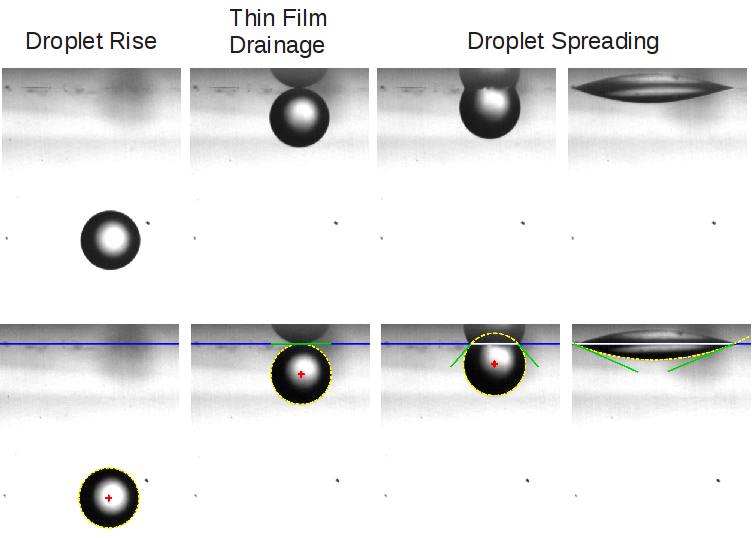|
SLIDING DROPLETS
Elucidating the
Mechanism of Lubrication for Sliding Droplets:
Hydrodynamics, Surface
Forces,
and the Role of Surfactants and Polymers
7th FP OF THE EU, SP3 PEOPLE
MARIE CURIE ACTIONS
INTERNATIONAL OUTGOING FELLOWSHIP (IOF)
PIOF-GA-2011-302803
|
Project operates in collaboration between:
Project Context and Objectives
Oily liquid
droplets suspended in water represent a large number of natural and
industrial products and materials. The properties of these colloidal
systems, termed emulsions, rely on many physicochemical
characteristics, such as oil/water ratio, relative viscosity of the
oil and water phases, the presence of polymers and surfactants, and
solution properties like pH and ionic strength. These
characteristics can be manipulated to produce the desired properties
relevant for the target application. Many of the applications of
emulsions are dependent on the interaction of the oily droplets with
solid surfaces, whether those surfaces are metals, metal oxides,
skin, or hair. Of the many areas of formulation for which emulsions
are used, their role as lubricants is central to food products and
personal care products, in addition to engineering applications such
as metalworking fluids. Flow properties, emulsion stability, oil film
formation, and texture perception are all important features of the
interaction between oil droplets and solid surfaces in these
applications.
The project
was designed with three objectives in mind: (i) altering
hydrodynamics of sliding droplets through manipulation of surface
forces; (ii) studying the influence of adsorbed surfactant and
polymer layers on droplet attachment and sliding; (iii) bridging the
gap to biological systems to look at cell attachment and sliding on
surfaces. By combining these three objectives, the desire was to go
from physicochemical modification of surface forces and sliding for
simple droplet systems, to practical application of the new knowledge
for cell flow and adhesion within microfluidic devices. The
methodology to be used included atomic force microscopy of
droplet-surface interactions (lateral and normal), spectroscopy of
oil-water interfaces, and microfluidic channel studies of droplet
flow and wetting film properties.
Description of Work
A necessary
precursor to the majority of studies planned was also included into
the project plan. This involved the study of droplet attachment to
solid surfaces, performed for free-rising and captive droplets in
solutions of varying composition. The attachment and spreading of
droplets on solid surfaces, and the dependence of these processes of
solution conditions and the presence/absence of polymers and
surfactants, is required to be studied before one can attempt
measurements of sliding (i.e. not attaching) droplets. Two molecules
know to stabilize droplets/emulsions were used: a stimulus responsive
peptide surfactant (AM1), and a hydrophobically-modified dextrin
(octenyl succinate anyhydride dextrin, trade name: Capsul).

The
adsorption of the molecules to the oil and solid interfaces was
studied using dynamic surface tension and quartz crystal
microbalance, respectively. In addition adsorption to these
interfaces was characterized as a function of solution pH (for AM1)
and solution ionic strength (for Capsul). The interaction of the
droplets with solid surfaces was interrogated using high speed video
microscopy and image processing, which allowed for the extraction of
the time for liquid film rupture between the droplet and the surface,
and for the dynamic dewetting (spreading of the oil droplet) for the
droplet-surface attachment. These processes were found to be highly
sensitive to the presence of surfactant or polymer at the solid
surface, and at the oil droplet surface, and also strongly dependent
on the pH and ionic strength of the solution through which the
droplet interacted with the solid surface. Attempts were made to
relate the droplet spreading to existing theories of dewetting (i.e.
molecular kinetic theory).

For systems
seen to be stable with respect to attachment and spreading, initial
experiments on droplet flow in microchannels were performed (as
planned in objectives (i) and (ii)). This involved the design and
fabrication of custom microfluidic devices for the creation and
surface modification of droplets, in addition to the controlled flow
and monitoring of droplet velocity. These experiments were initiated
toward the end of the first reporting period, and will continue into
the second reporting period. Planned experiment with the atomic
force microscope (objectives (i) and (ii)) did not take place in the
first reporting period due to the need to complete the abovementioned
studies prior to the commencement of normal and lateral force
measurement for droplet systems. These experiments will now take
place in the second reporting period.







